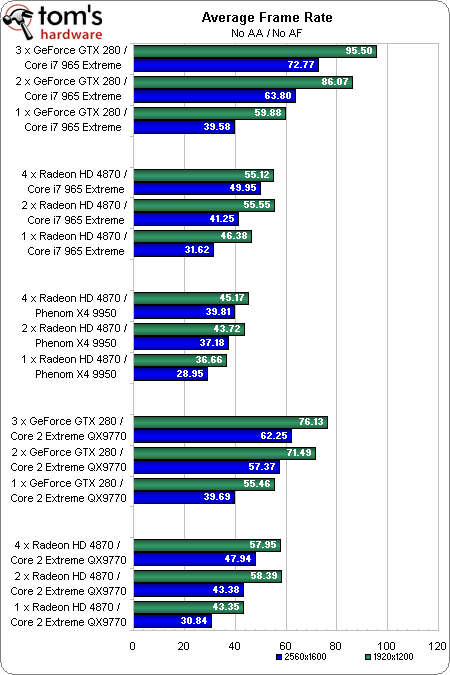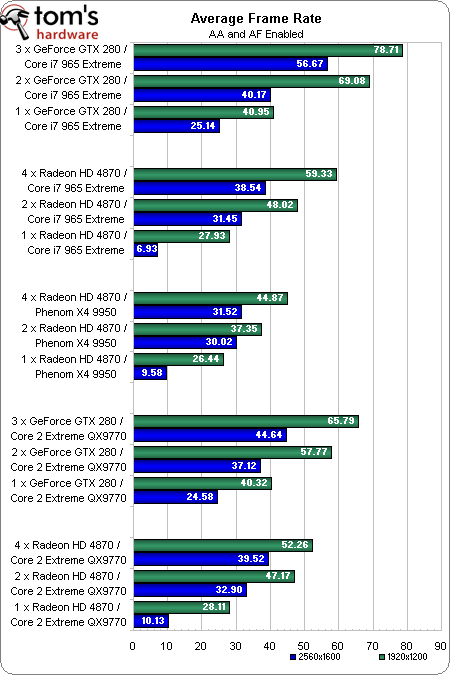Core i7: 4-Way CrossFire, 3-way SLI, Paradise?
Averaging It All Out
In the course of running the nearly 500 benchmark scores included in this exploration into Core i7 gaming, we ran into an abnormal number of fishy scores. Some were fairly explainable, while a great number of others are going to require follow-up with AMD and Nvidia—there is simply no reason some of the results should have been as low as they were.
So, to better smooth out the overall experience on each platform as a whole, we took the averages across all seven benchmarked games, ignoring 3DMark, and compiled them into the following two charts.

It’s almost uncanny to see how things smooth out, despite failed runs and uncharacteristically low numbers. First and foremost, compare gaming on Intel’s new Core i7 965 Extreme to gaming on the Core 2 Extreme. If you’re using a single GeForce GTX 280 or any combination of Radeon HD 4870 graphics cards, the experience really doesn’t change much overall. Drop in two or three GTX 280s, though, and the scores do increase noticeably.
Also, when the dust clears, AMD’s Phenom X4 9950 really doesn’t fare too poorly versus our other Radeon-based gaming platforms, especially when you consider the price difference. No, 2560x1600 is probably not going to be a viable gaming resolution for you in most cases, but at 1920x1200, the more mainstream system build handles business so long as you have two or more GPUs installed.

Turn on the eye candy and the GTX 280-equipped Core i7 really shines against Core 2 Extreme—most notably in a 3-way SLI configuration. We’re hoping that AMD is able to take a good, hard look at the scaling of its multi-GPU solutions, as the move from two to four RV770s is parallel at 1920x1200. It’s closer to Nvidia’s scaling at 2560x1200 in terms of percentage, but still substantially lower with regard to overall performance.
Get Tom's Hardware's best news and in-depth reviews, straight to your inbox.
-
DFGum Yep, i hafta say being able to switch brands of graphics cards on a whim and selling off the old is great. Knowing im going to be getting the preformance these cards are capable of (better price to preformance ratio) is nice also.Reply -
cangelini randomizerSLI scales so nicely on X58.Reply
Hey you even got a "First" in there Randomizer! -
randomizer cangeliniHey you even got a "First" in there Randomizer!And modest old me didn't even mention it. :lol:Reply -
enewmen Still waiting for the 4870 X2s to be used in these bechmarks. I thought THG got a couple for the $4500 exteme system. But still happy to see articles like this so early!Reply -
cangelini enewmenStill waiting for the 4870 X2s to be used in these bechmarks. I thought THG got a couple for the $4500 exteme system. But still happy to see articles like this so early!Reply
Go check out the benchmark pages man! Every one with 1, 2, 4 4870s. The 2x and 4x configs are achieved with X2s, too.
Oh, and latest drivers all around, too. Crazy, I know! =) -
enewmen cangeliniI found it, just read the article too quickly. - My bad.Reply
"A single Radeon HD 4870 X2—representing our 2 x Radeon HD 4870 scores—is similarly capable of scaling fan speed on its own. "
Hope to see driver updates like you said. -
spyde Hi there, my question regarding these benchmarks with the HD card is, "was a 2G card use or a 1G". I am about to buy a new system and was looking to buy 2 x HD4870X2 2G cards, but with these results its looking a bit ify. I hope you can answer my question.Reply
Cheers. -
Proximon That's a nice article. I especially like the way the graphs are done. everything is scaled right, and you get an accurate representation.Reply
